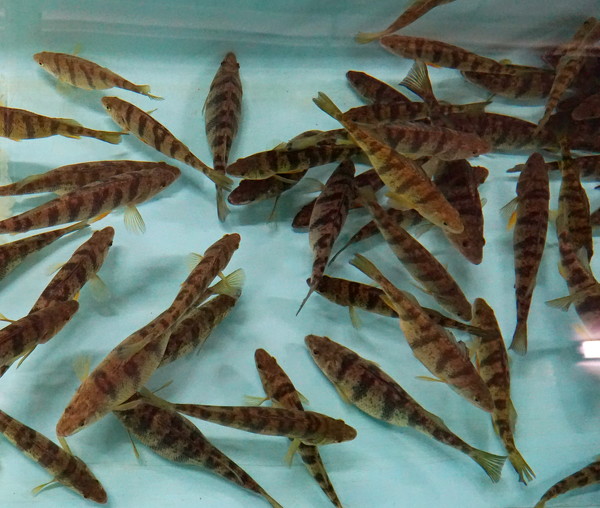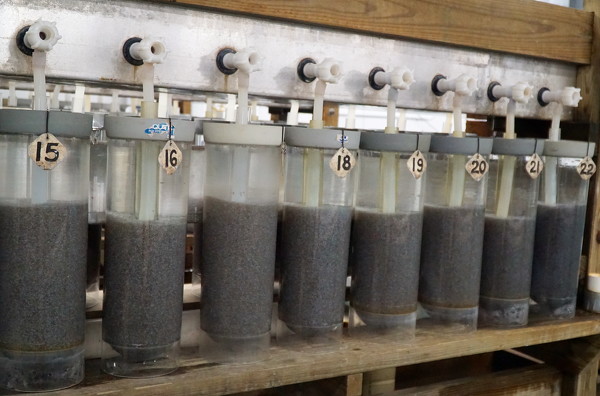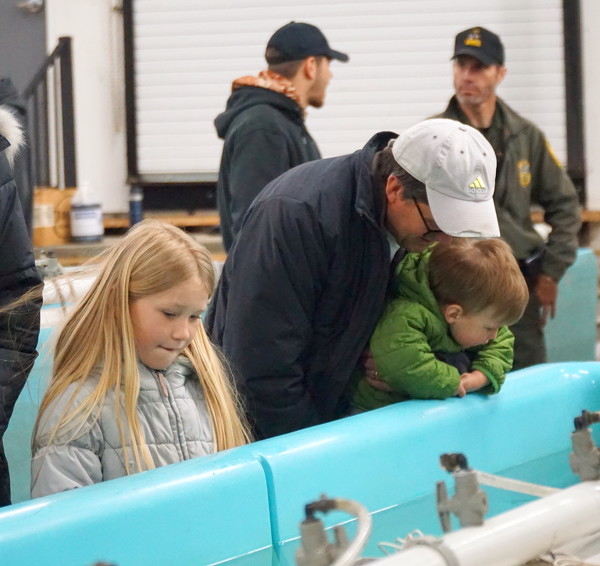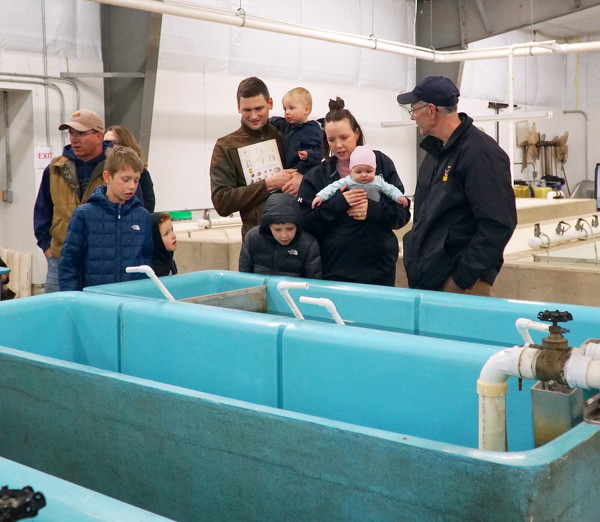Monday, March 28th, 2022
How do you like your eggs?
St. Marys State Fish Hatchery likes its eggs fertilized and shipped to lakes around Ohio
By Erin Gardner

Photo by Erin Gardner/The Daily Standard
Yellow perch swim around in a blue tank at the St. Marys State Fish Hatchery.
ST. MARYS-The cold and dreary weather Saturday didn't stop 332 people from touring St. Marys State Fish Hatchery as staff tended to 25 million yellow perch fish eggs and 50 million saugeye and walleye fish eggs.
"With the weather outside, I was up in the air (but) I'm thrilled to death with 300 people," Jay Williams, hatchery superintendent said.
At the front of the facility, several water-filled tanks contained yellow perch and to the right, there were long, cylindrical, churning incubation jars containing saugeye and walleye fish eggs. There were 70 jars of saugeye fish eggs and 36 jars of walleye fish eggs, Williams said. Each jar contained 450,000 eggs, which look like brown and white chia seeds. The brown eggs are fertilized and the white are unfertilized.

Photo by Erin Gardner/The Daily Standard
Incubation jars containing saugeye and walleye fish eggs are on display at the St. Marys State Fish Hatchery open house Saturday.
At the other end of the facility, several racks of trays were lined up. Williams said yellow perch eggs are incubated in trays. There were 200 trays with 125,000 eggs in each tray.
Williams said that of the 25 million yellow perch eggs, 87% will be fertilized and shipped to inland lakes in Ohio. Of the 50 million saugeye and walleye eggs, about half will be fertilized and shipped out as well.
The hatchery open houses are a popular event, being that they happen every three to four years, Williams said. The last open house was April 2019.
"I would say that people just want to get out of the house and are looking for something fun and different to do," Williams said of why the interest is so high. "I think people are just generally interested in seeing something that they don't usually see all that often. Sometimes, people never get a chance to see what we do."
Young children peered over the big, blue tanks with wonder. Several kids screamed in delight and pointed to the yellow perch swimming.

Photo by Erin Gardner/The Daily Standard
More than 300 people toured the hatchery Saturday.
To further engage interest, there were fish eggs under a microscope and shown on a screen. Outside, there was an archery range for kids to practice their shooting skills.
Williams has been hatchery superintendent for three years but has been with the hatchery for 25 years. He said he likes showing people what he does.
"I've always liked sciences and this is one arm of science that all seems to make sense," he said. "When you look at creating life for something and then you see how things live and grow, there's a whole bunch of little pieces of the puzzle that just come together. You grow something from nothing and make it a little bit bigger."
Behind the scenes, fertilizing fish eggs take time and practice.
"We actually take the eggs from the fish and we fertilize them ourselves, sometimes by hand, sometimes by putting the breeding pairs together," William said

Photo by Erin Gardner/The Daily Standard
Incubation jars churn fertilized and unfertilized saugeye and walleye fish eggs.
For perch, the hatchery has the parent fish in the ponds and they spawn once a year. Hatchery staff will drain the pond, take the breeding pairs inside and pair them up. They will give the fish hormone injections because the fish are at various stages of development, and the hormone injection synchronizes ovulation periods. This way, the hatchery can get a surplus of eggs in a short period of time. The staff gathers the eggs and lets them incubate for 12 days, after which they force hatch the eggs by stirring them with a paint stirrer.
For walleye and saugeye, it's a little different. The eggs come from Mosquito Creek Lake in Trumbull County because St. Marys hatchery doesn't have the parent fish there.
Williams said saugeye fish is a hybrid fish by combining a female walleye and male sauger. The male sauger fish come from the Ohio River and undergo disease testing.
The hatchery stocks a lot of up-ground reservoirs, which are city water impoundments, Williams said. Cities impound water from a river and then filter out the drinking water. However, William said the hatchery doesn't stock Grand Lake St. Marys and hasn't since 2020 because it wasn't seeing any return and couldn't justify the expense.

Photo by Erin Gardner/The Daily Standard
A group of people talk to hatchery superintendent Jay Williams.
In 2020, the hatchery stocked 3.7 million saugeye fry and 1.2 million fingerlings, 1.2 million walleye fingerlings, 4.1 million yellow perch fry and 1.8 million fingerlings,3,097 channel catfish catchables and 119,941 fingerlings and 93,164 blue catfish fry and 214,971 advanced fingerlings, according to ODNR. In 2021, the hatchery stocked 1.8 million saugeye fry and 3.4 million fingerlings, 1.6 million walleye fingerlings, 5.4 million yellow perch fry and 2.3 million fingerlings, 3,875 channel; catfish catchables and 167,711 fingerlings and 38,268 blue catfish fry and 112,777 advanced fingerlings.
Williams said fry and fingerling fish differ in development stages. Fry are fish that are a quarter-inch long and 1-5 days old. Anything older than that and they are considered fingerlings; fingerling fish are about two inches long.
Per year, the hatchery stocks 4 million yellow perch, 6-7 million saugeye fry, 3 million saugeye fingerlings, 3 million walleye fingerlings, according to Williams.
Although the hatchery doesn't stock Grand Lake, Williams said the lake has a rich history of fish being stocked, whether that's from the Ohio Department of Natural Resources Division of Wildlife or the U.S. Fish and Wildlife Service.
In 2020, ODNR stocked 556,861 yellow perch fingerlings and 1,897,500 fry in Grand Lake, according to ODNR's fish stocking records.
Located on 155 acres of land and 43 acres of water, the St. Marys State Fish Hatchery has 26 ponds, two outdoor raceways and nine indoor rearing troughs, according to ODNR. The water is supplied from Grand Lake and four wells.
The local hatchery off state Route 364 along Grand Lake's eastern shore is one of six in the state. The others are in Hebron, Senecaville, London, Castalia and Latham.





